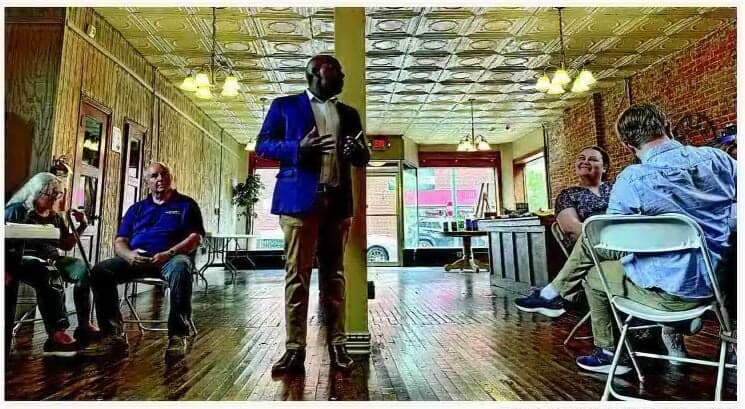PAINTSVILLE, Ky. — Janet Lynn Stumbo, 70, leaned on her cane and surveyed the two dozen or so voters who convened in a small Appalachian town to meet with the chair of the Kentucky Democratic Party.
A former Kentucky Supreme Court justice, Stumbo said the event was “the biggest Democratic gathering I have ever seen in Johnson County,” an enclave where Republican Donald Trump got 85% of the presidential vote last November.
Paintsville, the county seat, was the latest stop on the state party’s “Rural Listening Tour,” a periodic eff ort to visit overwhelmingly white, culturally conservative towns of the kind where Democrats once competed and Republicans now dominate nationally.
Democrats’ path back to power may start here, one small meeting at a time, because it will be difficult — if not impossible — for the party to regain U.S. Senate control or win the presidency without competing harder for rural and small town voters.
The party recently lost senators from states with significant rural populations: Montana, Ohio, Pennsylvania and West Virginia. Democratic-led states also lost population to Sun Belt states led by Republicans, with some projections suggesting Democrats would lose 12 seats in the Electoral College in the 2030 census.
“The gut check is we’d stopped having these conversations” in white rural America, said Colmon Elridge, the Kentucky Democratic chair. “Folks didn’t give up on the Democratic Party. We stopped doing the things that we knew we needed to do.”
It’s not that Democrats must carry most white rural precincts outright to win more elections. More realistically, it’s a matter of consistently chipping away at Republican margins in the way Trump narrowed Democrats’ usual advantages among Black and Latino men in 2024 and not unlike what Kentucky’s Democratic governor, Andy Beshear, did in two statewide victories.
Nationally, Trump won 60% of small town and rural voters in 2020, according to AP VoteCast data, and 63% in 2024. That’s a far cry from a generation ago, when Democrat Bill Clinton won pluralities in Johnson County on his way to capturing Kentucky’s electoral votes in the 1992 and 1996 White House races.
“We have to be intentional about how we build something sustainable,” Elridge said. “It’s not like we haven’t won here before.”
For two hours in downtown Paintsville, Elridge listened as Stumbo and others took umbrage at conservatives’ policy agenda, expressed frustration over Trump’s standing in eastern Kentucky and said they were determined to sell their neighbors an alternative. Many brought their personal experiences to bear.
Sandra Music, a retired teacher who called herself “a new Democrat,” converted because of Trump. She bemoaned conservatives’ success in advancing private school tuition voucher programs and said they were threatening a public education system “meant to ensure we educate everybody.”
Music criticized Republicans for making a “caricature” of Democrats. “They want to pull out keywords: abortion, transgender, boys in girls’ sports” and “distract” from the rest of the Republican agenda, she said.
Stumbo lamented what she called the rightward lurch of the state and federal courts.
Michael Halfhill, who works in health care information technology, was incredulous that the billionaire president took hold of voters in Appalachia, historically one of the country’s poorest regions.
“It’s not left vs. right. It’s rich vs. poor,” he said, shaking his head at working-class white voters — Johnson County is 97.5% white — “voting against themselves.”
Ned Pillersdorf, who is married to Stumbo, went after Republicans for their proposed federal tax and spending plans, especially potential cuts to Medicaid. He said Paintsville still has a rural hospital, which is among the largest employers in the region, in no small part because Kentucky is among the GOP-leaning states where a Democratic governor expanded Medicaid under the 2010 Affordable Care Act.
Elridge, the first Black chair of a major party in Kentucky, mentioned Trump’s attacks on diversity, equity and inclusion initiatives and related civil rights laws and regulations.
Elridge and Nicholas Hazelett, the Johnson County Democratic chair who is a college student doubling as a Paintsville City Council member, acknowledged that the small crowd was Democrat-friendly. No one was there waiting to be convinced.
Across the street, antiques shop owner Michelle Hackworth said she did not even know Democrats were holding a meeting. Calling herself a “hard-core Republican,” she smiled when asked if she considered attending.
“They wouldn’t convince me of anything,” she said.
Bill Mike Runyon, a self-described conservative Republican who is Paintsville’s mayor and loves Trump, went immediately to social and cultural commentary when asked in an interview to explain Johnson County politics.
Democrats, he said, “have to get away from the far-left radical — look at the transgender message.” Further, Runyon said, “Everything got kind of racial. It’s not like that here in Paintsville and in Johnson County, but I can see it as a country. … It’s making people more racist against one another.”
Asked who he was talking about, he alluded to progressive U.S. Reps. Alexandria Ocasio-Cortez, a Latina from New York City, and Jasmine Crockett, a Black woman from Texas. “It’s the ones you always see on TV,” the mayor said.
Beshear seems to be the one Democrat who commands wide respect in and around Paintsville.
Democrats hailed the 47-year-old governor for supporting abortion and LGBTQ+ rights while still attracting support beyond Democratic strongholds. Beshear did not win Johnson County, but got 37% of its vote in his 2023 reelection and carried several nearby counties.
Multiple Republicans, including the mayor, complimented Beshear for his handling of disasters in the region.
“He’s been here,” Runyon said. “I absolutely can get to him if I need him.”
